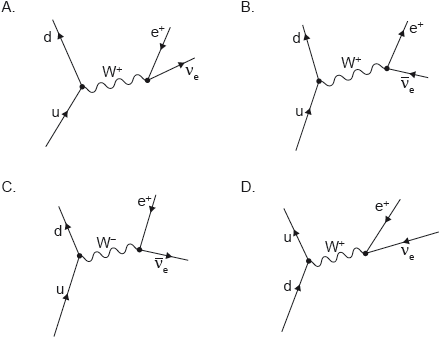| Date | November 2016 | Marks available | 1 | Reference code | 16N.2.SL.TZ0.4 |
| Level | Standard level | Paper | Paper 2 | Time zone | 0 - no time zone |
| Command term | State | Question number | 4 | Adapted from | N/A |
Question
A particular K meson has a quark structure s. State the charge on this meson.
The Feynman diagram shows the changes that occur during beta minus (β–) decay.
Label the diagram by inserting the four missing particle symbols.
Carbon-14 (C-14) is a radioactive isotope which undergoes beta minus (β–) decay to the stable isotope nitrogen-14 (N-14). Energy is released during this decay. Explain why the mass of a C-14 nucleus and the mass of a N-14 nucleus are slightly different even though they have the same nucleon number.
Markscheme
charge: –1«e» or negative or K−
Negative signs required.
correct symbols for both missing quarks
exchange particle and electron labelled W or W– and e or e–
Do not allow W+ or e+ or β+ Allow β or β–
decay products include an electron that has mass
OR
products have energy that has a mass equivalent
OR
mass/mass defect/binding energy converted to mass/energy of decay products
«so»
mass C-14 > mass N-14
OR
mass of n > mass of p
OR
mass of d > mass of u
Accept reference to “lighter” and “heavier” in mass.
Do not accept implied comparison, eg “C-14 has greater mass”. Comparison must be explicit as stated in scheme.


